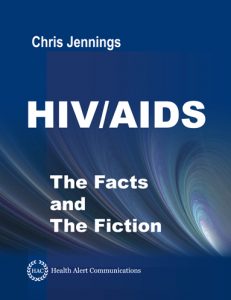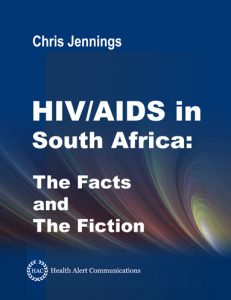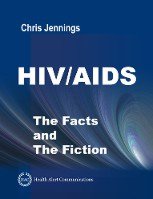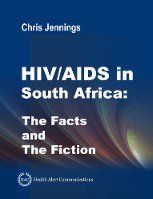 The first Africans diagnosed with AIDS were two white gay men who lived in the Republic of South Africa [1]. (The Republic of South Africa is typically referred to as “South Africa.”) As was typical for every AIDS case outside the United States early in the AIDS epidemic, both of these South African gay men caught AIDS in the United States.
The first Africans diagnosed with AIDS were two white gay men who lived in the Republic of South Africa [1]. (The Republic of South Africa is typically referred to as “South Africa.”) As was typical for every AIDS case outside the United States early in the AIDS epidemic, both of these South African gay men caught AIDS in the United States.
Both of these men were gay male air stewards (flight attendants) who had visited the United States before the development of their disease [1], and both died from Pneumocystis carinii pneumonia (PCP), a classical early-onset opportunistic infection secondary to HIV infection.
The first patient was seen by his doctor in early 1982, “complaining of episodes of ‘influenza’ with increasing weight loss,” making him Africa’s first AIDS case. He was also one of the first AIDS cases in the world.
At that time, almost all the world’s AIDS cases had occurred in the United States and almost exclusively among gay men and IV drug users. For example, as of August 1981, the United States had 108 reported AIDS, 95 of them were gay or bisexual men [2].
The first South African AIDS patient died in November 1982. His ‘influenza” was diagnosed as PCP at autopsy. The second patient died December 1982. He had visited the United States only 3-4 months before becoming ill. His course of disease was rapid (and, no, HIV infection does not have a 10-year incubation period, see my blog post HIV has a 10-Year Incubation Period – NOT). Comparatively, as of September 1982, the United States had a total of 593 AIDS cases, 95% of these cases among gay men and IV drug users (or both) [3].
Meanwhile, no other AIDS cases had been reported in Africa. (Perhaps you have heard of supposed “AIDS cases” in Africa dating to back to 1959, discovered retrospectively, but most likely they were forms immunodeficiency induced by genetic disorders, over 150 such genetic disorders have been identified [4, 5].)
Remember, at this time, the cause of AIDS was unknown. HIV had not been discovered. No HIV antibody test existed. Patients were diagnosed with “AIDS” after they developed opportunistic infections.
Initially, it was thought that some aspect of gay lifestyle caused AIDS. It even seemed doubtful whether women were susceptible to the disease. However, as IV drug users, hemophiliacs, and female sexual partners of IV drug users started coming down with AIDS, it became evident that some unknown infectious agent was responsible.
Early in the AIDS epidemic, the disease seemed almost exclusive to the United States, and the United States was recognized as the global epicenter of HIV/AIDS. This perspective of the United States being the epicenter of AIDS is evident in the medical literature of the time. For example, here is a quote from the published report on these first South African AIDS patients [1]:
Although most [AIDS] cases have been reported from the USA, some have been reported from other countries; initially these occurred in patients who had visited the USA before contracting the disease, but lately the disease has been recorded in individuals who have never visited that country.”
Unfortunately, this comment by South African physicians reveals a common weakness among many authors of scientific and medical journal articles: they cite articles after reading the abstract only; and fail to sufficiently attend to the body of the article (if they read its entirety at all).
The South African physicians were citing a published report on the first 4 AIDS patients in Denmark [6]. The abstract of this article states: “Two patients were sexual partners and three had never been to the USA.” However, the Discussion section of the article stated:
Three of the [AIDS] cases were the first to be reported in patients who had not previously visited the USA. This indicates that the disease can be acquired outside the USA. All four patients, however, had had sexual contact with homosexual men who had visited or lived in the USA [6].”
By general perception, the onset of the HIV/AIDS epidemic is considered to be June 1981. Therefore, as of December 1982, no black Africans had been diagnosed with AIDS.
All across the world, all AIDS cases outside the United States occurred only among gay men who had caught AIDS (directly or indirectly) from American gay men; and, across the world, the initial inceptions of HIV/AIDS occurred in cities with strong business and tourist connections with the United States [7].
Related Blogs:
- How Laboratory Contamination Spawned the Theory that HIV came from African Monkeys (Video)
- How Laboratory Contamination Spawned the Theory that HIV came from African Monkeys (Text)
- The Implausibility of HIV/AIDS Statistics in South Africa (Video)
- The Implications of Bad HIV/AIDS Science in Africa
- HIV / AIDS The Facts And The Fiction
- HIV / AIDS in South Africa: The Facts and The Fiction
References:
[1] Ras GJ, Simson IW, Anderson R, Prozesky OW, Hamersma T. Acquired immunodeficiency syndrome. A report of 2 South African cases. S Afr Med J. 1983 Jul 23;64(4):140-2. [PMID: 6306851]
[2] Centers for Disease Control (CDC), Follow-up on Kaposi’s sarcoma and Pneumocystis pneumonia. MMWR Morb Mortal Wkly Rep. 1981 Aug 28;30(33):409-10. [PMID: 6792480].
[3] Centers for Disease Control (CDC). Update on acquired immune deficiency syndrome (AIDS)–United States. MMWR Morb Mortal Wkly Rep. 1982 Sep 24;31(37):507-8, 513-4. [PMID: 6815471] [Full Text at cdc.gov]
[4] (APIIEG) APIiIEGI. Consensus Recommendations for the use of Immunoglobulin Replacement Therapy in Immune Deficiency. 2nd Edition, July 2009 ed; 2009.
[5] Notarangelo LD. Primary immunodeficiencies. J Allergy Clin Immunol. Feb 2010;125(2 Suppl 2):S182-194. [PMID: 2004222]
[6] Gerstoft J, Malchow-Møller A, Bygbjerg I, Dickmeiss E, Enk C, Halberg P, Haahr S, Jacobsen M, Jensen K, Mejer J, Nielsen JO, Thomsen HK, Søndergaard J, Lorenzen I. Severe acquired immunodeficiency in European homosexual men. Br Med J (Clin Res Ed). 1982 Jul 3;285(6334):17-9. [PMID: 6805793 ] [Free PMC Article]
[7] See the section “HIV/AIDS Migrates Overseas” in HIV/AIDS – The Facts and The Fiction.






Leave a Reply